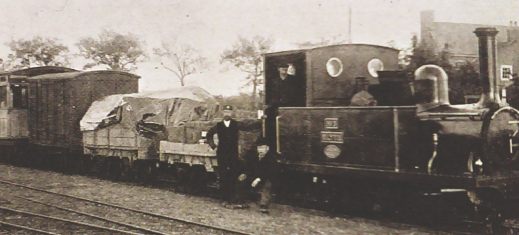
Southwold Railway Trains were almost always mixed – with a selection of freight vehicles marshalled between the locomotive and the passenger coaches. The railway’s ability to move large quantities of goods – mainly coal, but also a very large variety of general merchandise – was almost as important to the local economy as was the lucrative passenger trade.
Except for the van body, well looked after and beautifully displayed at the East Anglia Transport Museum, the entire stock of the SR was scrapped during WWII.
So, as part of the Trust’s efforts to revive and rebuild the railway, we thought that it would be appropriate to draw together the various disparate rolling stock we work on, and make a commitment to build a complete Southwold Railway Heritage Train, as ran in 1879. Officially launched to the public in two main formats – in Narrow Gauge World magazine on October 31st, and at the Warley Show at the NEC on November 22nd and 23rd – the Project will appear on this website during the month: meanwhile, all monies, to the Trust office, would be very welcome indeed.
The first part of this is Van 40, already familiar to regular readers of this blog: the ex. Royal Navy underframe, now completely rebuilt, is about to move to the Special Objectives for Local Disabled (SOLD) workshop in Lowestoft, where, with involvement from SRT volunteers, the body will be completed. Included within the Project is the grounded van body (identical to the body for the working van) for our Wenhaston Station site – if only because we need it, and it seems to fit.
The next vehicle is Open Wagon 41 – we have the donated underframe (again ex. Navy) for this. The four-wheeled high-curved-end open is a classic SR wagon, and will be discretely modified to double as a flat when this is needed.
Then, naturally, there’s a coach – SR tramway-style Brake Composite coach No 8, as near as possible (keeping modern regulations in mind) to the original, with its distinctive end balconies and longitudinal seats. Some concessions will be necessary – disabled access, for example – but this can be provided without much modification to the body. The underframe is a more complex question: though it would be satisfying to build the flexible Cleminson 6-wheel mechanism, it may prove hard to get such an unusual piece of engineering certificated for public use. If so, we will use bogies.
All the stock will need to be fitted with continuous brakes (something the SR never had), but we are planning a system that is as unobtrusive as possible.
The gem is of course 2-4-0T Sharp Stewart locomotive No 3 “Blyth” – this is not strictly part of the Heritage Train Project, as it already has its own Fund. However, the locomotive new-build project, which we plan to re-launch in late winter, is naturally an integral part of the concept.
As far as we know, this has never been done before. No three-foot-gauge nineteenth-century stock, and particularly no freight stock, has ever been replicated, and neither has such a locomotive been built – anywhere.
Since being launched to members, the fund has already accumulated over £5,500 in a few weeks: the grounded body is funded, as is the structure of Van 40, transport for Wagon 41, and preliminary work for the coach. But we need a lot more. We estimate that the completed cost of the train of three vehicles (less the loco), with continuous brakes, and the necessary fitness to run certification, will cost around £145,000 more, with volunteers sharing the work with contractors. The timescale is five to ten years – the more cash that comes in, the quicker we will finish. If 242 people were able to donate only £10 a month over five years, we’d be there. “Blyth” will cost a great deal more, of course, but then the prize is – perhaps – a more tempting one. Future blogs will outline the sponsors’ privileges that will be available – above and beyond the satisfaction of helping such a unique and ambitious project to come to fruition.
It will be said that the Trust is foolish to embark on such a large and expensive project when it (so far) has no railway – but there’s no point at all in fighting tooth and nail for a railway, when there’s nothing authentic to run on it!
